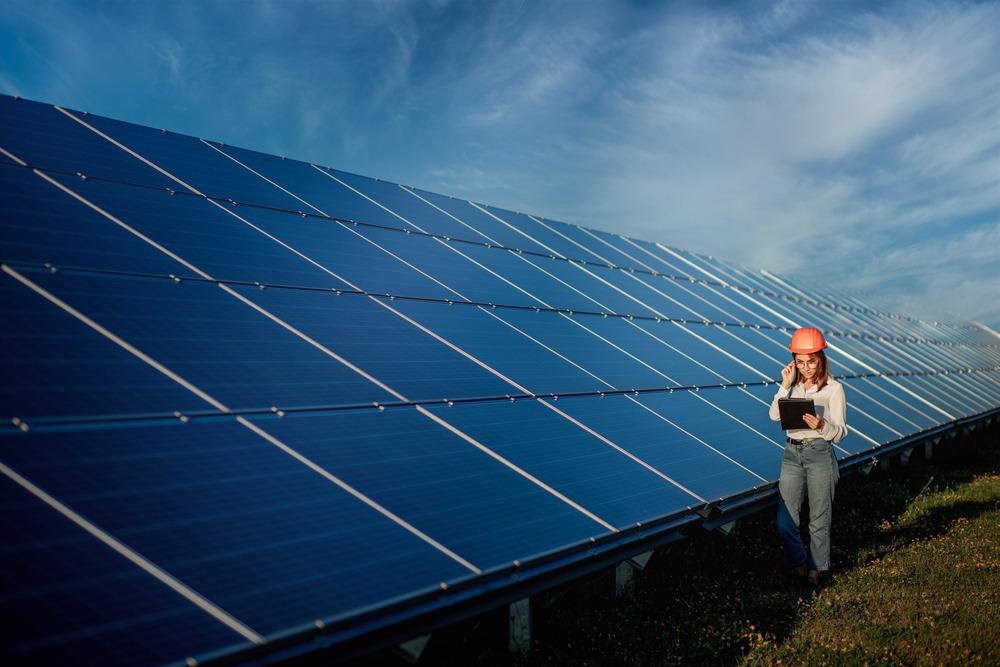Perovskites have emerged as attractive materials for the design of next-generation photovoltaic solar cell devices due to their excellent properties. However, like all materials, fine-tuning these properties to improve their application is a central focus of current research on perovskites.

Study: Realizing High-Efficiency and Stable Perovskite Solar Cells via Double-Perovskite Nanocrystal Passivation. Image Credit: Volodymyr Maksymchuk/Shutterstock.com
New research published in ACS Applied Energy Materials has investigated the modification of hybrid perovskite solar cells using double-perovskite nanocrystals.
Perovskites: Attractive Materials for Photovoltaic Applications
Organic-inorganic hybrid perovskite materials have been widely explored for their applications in photovoltaic devices for energy harvesting. They possess superior optoelectronic properties including tuneable bands, small exciton binding energy, enhanced light absorption compared to conventional materials, and long carrier-transport lengths.
Recent studies have reported a power conversion efficiency exceeding 25% for single-junction perovskite solar cells, which exceeds multi-crystalline silicon solar cells. The displayed efficiency is comparable to single-crystalline silicon solar cells. Significant research has been conducted to improve the power conversion efficiency of perovskite cells beyond that of current generations of photovoltaic devices.
A major drawback of organic-inorganic hybrid perovskite solar cells is their instability. Despite their superior optoelectronic performance, this limits their practical applications in the field of solar energy harvesting.
Double-Perovskite Materials
Due to these drawbacks, there has been research focused in recent years on fabricating perovskite materials that display enhanced stability whilst retaining or surpassing the optoelectrical properties of hybrid-perovskite materials.
Research in the area has led to the development of a new class of novel perovskite materials – double-perovskites. These materials display superior photoelectric properties and have intrinsic stability that surpasses that of organic-inorganic hybrid perovskites. Double perovskites display the immense value in terms of luminescence and detection, particularly in X-ray detection.
Despite their better overall performance than hybrid perovskite materials, double perovskites still suffer from a wide bandgap, which reduces their power conversion efficiency. This, again, limits their applications in next-generation photovoltaic devices.
A New Strategy: Combining Double-Perovskites and Organic-Inorganic Hybrid Perovskites
Because of these limitations, the authors of the research paper in ACS Applied Energy Materials have demonstrated a new strategy that takes advantage of the superior power conversion efficiency of hybrid perovskites and the enhanced stability of double perovskites. The aim of the research is to facilitate the fabrication of high-performance solar cells.
The fabrication methodology makes use of double-perovskite nanocrystals to modify the interface of perovskite materials, thus introducing double perovskites into perovskite photovoltaic solar cells. Current literature in the field has demonstrated the superior photoelectric properties of double perovskite nanocrystals which are inherited from bulk materials. Additionally, they have properties such as good crystallinity and tunable band structures. They also display superior quantum confinement effects.
Further Reading: Microbiota Survival on Photovoltaic Panel Materials
The team introduced a double perovskite nanocrystal (Cs2AgBi0.1In0.9Cl6) into the interface layer of a hybrid organic-inorganic perovskite. This significantly reduced the interface defects after modification. Voltage loss was reduced whilst the open circuit voltage was increased from 1.05 to 1.14V. Power conversion efficiency increased from 17.9 to 19.9%. This was 11.2% higher than the control devices used in the research. The fill factor and short-circuit photocurrent density remained largely unchanged.
The optimal concentration of perovskite nanocrystals was 80 μg/mL. Lower concentrations of nanocrystals did not significantly enhance the device's performance. Similarly, introducing higher concentrations (such as 800 μg/mL) significantly reduced the performance. The most obvious decline was in the short-circuit photocurrent density and the fill factor. This was due to the presence of excessive nanocrystals on the interlayer surface which negatively impacted hole transport.
Additionally, the presence of excessive double perovskite nanocrystals induced defects in the layer by reducing the uniformity and flatness of the film, again degrading the performance of the modified perovskite materials. Other effects were observed and discussed in the study.
The perovskite nanocrystals functioned as a protective barrier for the perovskite layer. This enhanced the stability of the device significantly. The authors have stated that by improving both the photoelectric properties and the stability of the hybrid perovskite materials, perovskite nanocrystals improve the application value of perovskite materials for optoelectronic devices.
The Future
The research published in ACS Applied Energy Materials has demonstrated the fabrication of novel perovskite material, wherein organic-inorganic hybrid perovskites are modified by the inclusion of double perovskite nanocrystals. The resulting material displays enhanced stability and improved photoelectric properties at an optimal nanocrystal concentration of 80 μg/mL.
This hybrid material significantly improves the application potential for next-generation perovskite photovoltaic solar cells which will help to move the world away from its over-reliance on fossil fuels toward an increasingly renewable energy mix.
Further Reading
Zhang, Z et al. (2022) Realizing High-Efficiency and Stable Perovskite Solar Cells via Double-Perovskite Nanocrystal Passivation [online] ACS Appl. Energy Mater. | pubs.acs.org. Available at: https://pubs.acs.org/doi/10.1021/acsaem.1c03544
Disclaimer: The views expressed here are those of the author expressed in their private capacity and do not necessarily represent the views of AZoM.com Limited T/A AZoNetwork the owner and operator of this website. This disclaimer forms part of the Terms and conditions of use of this website.